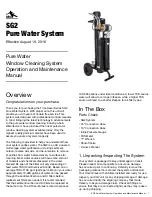
7.4 Bearing removal
1.
Ball bearings
A puller such as the one shown in
Figure 42: Bearing puller on page 48
should be used. The
puller bar must be square with the end of the shaft at all times in order to keep even pressure on
the outer circumference of the bearing. The puller screw should be tightened steadily to enable
the bearing to slide smoothly off the shaft. Do not damage the end of the shaft.
Figure 42: Bearing puller
On some units, the bearing housings slide off the bearings and the puller such as the one shown
in
Figure 43: Bearing puller for units with bearing housings that slide off bearings on page 48
should be used. This type of puller pulls directly against the bearing itself. The puller bar must be
square with the end of the shaft at all times and the puller screw should be tightened steadily to
enable the bearings to slide smoothly off the shaft. Do not dame the end of the shaft.
Figure 43: Bearing puller for units with bearing housings that slide off bearings
2.
Sleeve bearings
After the bearing shells have been removed, a bearing puller, such as shown in
ing puller for units with bearing housings that slide off bearings on page 48
, should be used to
remove the ball bearing. The puller bar must be square with the end of the shaft at all times and
the puller screw should be tightened steadily to enable the bearing to slide smoothly off the shaft.
Do not damage the end of the shaft.
After the bearings have been removed, they should be wrapped in clean paper or cloth to prevent
contamination. Other parts which surround the bearings, such as bearing housings, should be
kept clean in the same manner.
7.5 Ball bearing installation
A film of clean machine oil should be applied to the bearing seat on the shaft. The bearing should be
started on the shaft by tapping the inner race with a hammer or mallet. Do not use a lead mall. The
7.4 Bearing removal
48
Model 3415 Installation, Operation, and Maintenance Manual












































